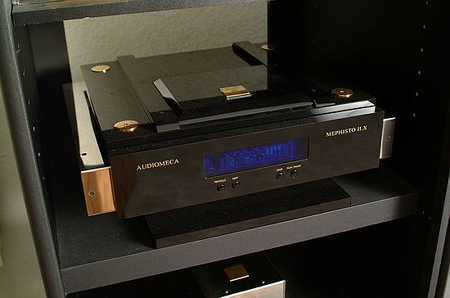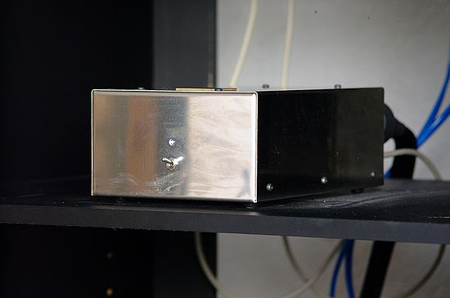You are reading the older HTML site
Positive Feedback ISSUE
15
september/october 2004
audiomeca
Mephisto II.X CD player
as reviewed by John Beavers

|
JOHN BEAVER'S SYSTEM
LOUDSPEAKERS
ELECTRONICS SOURCES CABLES
ACCESSORIES
|
What makes a CD player worth the asking price of the Audiomeca Mephisto II.X? What does this player provide that more moderately priced source components do not?
The Mephisto arrived double boxed, packed with plenty of protective material. The unit has a suspended subchassis that has foam wedges inserted between it and the base unit when shipped. The wedges are located at the gold knobs that contain the screw holes for raising and lowering the subchassis. The first step is to remove the foam and the transport screws, two between the gold knobs and one behind the transport drawer. The manual describes how to raise the chassis platform, but a bit of confusion is caused by the translation of French into English. The manual tells you to turn the screws "anti-counterclockwise." Literally that means clockwise, but the screws should be turned counterclockwise three revolutions. At this point, the supplied bubble level device is used to fine-tune the suspended chassis. It does not have to be exact, but I'm a perfectionist, and I got that bubble as dead center as humanly possible.

Next you hook up the outboard power supply ("Alimentation Box") with the provided cables. It does not matter which of the two power supply outputs you use to connect to the two inputs on the player. One is for powering the transport, the other is for the DAC. Next up is the power cable, but unless you live in Europe, you're out of luck. It's European, and there's no adapter, so get out one of your boutique power cables and hook it up. Flip the switch on the power supply box and you're ready to go.
Before we get to the sound, I have to talk about the looks of the player. This is not something that usually rates high on my list of important attributes, but the Mephisto's styling certainly captures the eye. It is, in a word, beautiful, with its sleek lines and glistening black color in lusciously contrast to the four golden knobs in the corners. The stand that is part of the player gives it the look of a futuristic spacecraft ready for launch. Previous reviewers have mentioned that the remote is somewhat cheap looking. I found it to be an easy fit in the hand and completely unobtrusive. Remotes that are like five-pound lead weights are supposed to give you a sense of solid construction and refinement. I find them a pain to deal with, though they could come in handy as home protection devices. The buttons on the Mephisto's remote are well spaced, and the functions are easily seen.
The first thing that impressed me about the Mephisto was the soundstage. I've heard decent-sized soundstages in the past, but no player has given me this sense of spaciousness. On live recordings, the concert hall or club came alive with a panoramic sense of space. Clinking glasses could be heard from a table a few feet in front of me. Whispered conversations were discernible as the band started playing, with a quiet buildup to the flurry of sound that came later. The high frequencies had sparkle and bite. Bells, vibes, and chimes literally floated in the air, with a crystalline quality that I felt I could touch with my fingers if I were quick enough. Voices had a natural texture that sounded very right to my ears. Bass was hard hitting, controlled, and very earthy.
The other intriguing aspect of the Mephisto was its speed. The player was quick on the snap of a note, with blazing transients. My ribbon monitors appreciated this. They came alive under the Mephisto's direction. Every piece of music that I played jumped out at me with authoritative pace and rhythm. One of my musical passions is acoustic guitar. To finally be able to hear the faintest of details, like the subtle resonances revealed in the pluck of a string and the movement of fingers over polished wood, was intoxicating. Everything I played on the Mephisto sounded dramatic, though it could do the subtleties as well—the faint sounds, or the stillness of a pause, that are so important to the tension built by a powerful piece of music. The Mephisto is a master of all the elements that encompass world-class musical reproduction.
After a couple of months of musical paradise, a change occurred. It was subtle at first. The sparkle of the high notes became slightly more mundane. The midrange became flat. Bass that had been hard hitting became slightly mushy. The spaciousness that had enraptured me became more closed in. What was going on? I first presumed that my preamp was the culprit, figuring that a tube was going bad. After changing 12AU7s, things picked up a little, but the dynamics, spaciousness, and cutting edge that had been the mark of the Mephisto remained lacking. I lived with it for awhile, then decided to move on to another player. Before I could sell it, things got worse. CDs would either sputter or lock up on the last track. It was time to contact my dealer, but unfortunately he had gone out of business. He did reply to my email, and told me to contact the US distributor. The distributor was in the process of moving his business, and was not reachable.
I then contacted Audiomeca in France. After two weeks of getting no response, I began to get that sinking feeling of owning a very expensive paperweight. It turned out I had picked the absolute worst time to have a problem with the player. Pierre Lurne had been involved in an auto accident, and was hospitalized at the time I sent my request. Once he was back in the office, he responded, and we worked out a solution—a scary one for me, with my limited ability to deal with electronics. The drive was the cause of my problem, so he was going to send a replacement drive, and I was going to attempt to install it. The installation took some time, but Pierre was with me every step of the way. If I got confused, I'd send an email and have my answer the next day. Eventually I was able to fit all the pieces of puzzle together, and believe it or not, the thing worked!
Having not heard a healthy Mephisto for over a month, I found myself falling in love all over again. The new drive brought out all the qualities I'd been missing and then some. It sounded more dynamic, with more soundstage depth and width and more tonal richness, and the highs were once again titillating my senses. During my communications with Pierre, I had a chance to ask him some questions. I was curious about the stand the player was perched upon. Was it just for style, or did it serve a function? It turns out that the stand contains a lead mass that provides vibration damping. The stand also lowers the center of gravity for the mechanism. My next question was about the suspended chassis. I had assumed that it was a shock absorber. However, if I jumped up and down near the player, the CD would skip. Pierre gave the following explanation:
"When two bodies are separated by a soft material, like a tonearm and the stylus cantilever assembly, with the cartridge suspension in the middle, like everything suspended or decoupled on this earth, you have an oscillator with a frequency of resonance. On one side, all works as one solid piece, but on the other side things are separated. Add resonance and you get big trouble, but you can choose the frequency for minimum disturbance. With a CD player or something similar, on very low vibrations—if the house moves, for instance—it will skip. On higher frequencies, the player is isolated. Things are obviously much more complex, and total isolation is impossible, and not even hoped for, but with some care you can get rid of the rest."
My last question was about the trend of having a tube stage in CD players. Why did Audiomeca choose to go solid state? Pierre responded, "I love tubes and have tube equipment at home. I love the sound and the old fashioned touch. This is the heart side. At the company I must be serious, and the head has to command. Twenty years ago, one could hesitate between tube and solid state. Today it is different. One can make a pretty good output audio stage with either of the two technologies. All depends on how the stage has been done. That is the reality. Tubes do not necessarily mean quality any more. There are some pretty good arguments in favor of solid state these days. I do not prefer one over the other, but it is the perfect time for audiophiles to consider that a belief in magic may not be in their best interest. Examples are numerous. Tubes can work wonderfully, or can be there to play the commercial game, or both."
In answer to my original question, what makes a player worth the price of the Audiomeca Mephisto II.X? No other player that I've owned has come close to the level of realism that the Mephisto provides. This was brought home to me when the Mephisto went down, and I went back to listening to music on my Samsung HD-1000 DVD player. This is not a cheap player. It is well designed and considered audiophile grade, yet there was no magic, and no realism compared to the Mephisto. There's no going back now. I've tasted the proverbial apple, and it is grrrrrreat! John Beavers
Mephisto II.X
Retail: $6800
Audiomeca
web address:
www.audiomeca-hifi.com
